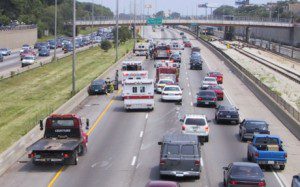By Matthew Salit*
Seekonk H.S., Seekonk, MA
EndDD Student Intern
 Along with beach days and long road trips, the summer months between Memorial Day and Labor Day mark the 100 deadliest days for teens behind the wheel. Distracted driving as a result of cell phone use continues to be a leading cause of crashes, but new efforts are being made to allegedly, make the use of cell phones in vehicles safer.
Along with beach days and long road trips, the summer months between Memorial Day and Labor Day mark the 100 deadliest days for teens behind the wheel. Distracted driving as a result of cell phone use continues to be a leading cause of crashes, but new efforts are being made to allegedly, make the use of cell phones in vehicles safer.
Autonews.com reports that Google and Apple, manufacturers of popular smartphones, have recently announced plans to incorporate technology that disables the screen of the phone when it is connected to a car. Android Auto, from Google, and CarPlay, by Apple, allow drivers to access most of the capabilities of a smartphone without the visual distraction of the device. Drivers can use vehicle controls to text, make phone calls, navigate and play music from streaming services, mostly by voice commands.
Although these tools appear to be a promising compromise between cell-phone-savvy drivers and traffic safety advocates, hands-free does not mean distraction-free. (See:” Cognitive Distractions: Hands Free vs. Hand Held & Voice to Text” in the “Research and Statistics” page on this site). According to the AAA Foundation for Traffic Safety, speech-to-text technologies do not necessarily make the driver any safer because mental distractions can cause a crash. The cognitive demands of using a smartphone via Android Auto or CarPlay result in a very high level of distraction that adversely affects driving capabilities.
As previously noted in an article about the dangers of Google Glass, motorists cannot multi-task behind the wheel because driving as its own activity is cognitively demanding. In fact, multi-tasking is a myth, we don’t do two things at once, but rather, we switch attention from one task to the next. Thus, Android Auto and CarPlay are unintentionally providing a false sense of safety behind the wheel by taking away the physical device without removing the distractions of cellular communication.
I believe that the concept of preventative tools to correspond with stronger safe driving laws will help to prevent distracted driving and save lives. Ultimately, only widespread change in how motorists view safety and distracted driving will eliminate the behavior and make roads across America safer for all.
*  Matt Salit is a senior at Seekonk High School in Seekonk, Massachusetts. He and his 2 brothers, Brian and Timothy ( triplets), have been in involved in distracted driving issues for the last 2 years. Together, they organized the Massachusetts Teen Distracted Driving Leadership Conference in 2013 and 2014, impacting over 70,000 teens. To date, these conferences have been the largest statewide distracted driving conferences organized by teens for teens. EndDD is thrilled to have this outstanding young man intern with us for the summer.
Matt Salit is a senior at Seekonk High School in Seekonk, Massachusetts. He and his 2 brothers, Brian and Timothy ( triplets), have been in involved in distracted driving issues for the last 2 years. Together, they organized the Massachusetts Teen Distracted Driving Leadership Conference in 2013 and 2014, impacting over 70,000 teens. To date, these conferences have been the largest statewide distracted driving conferences organized by teens for teens. EndDD is thrilled to have this outstanding young man intern with us for the summer.





